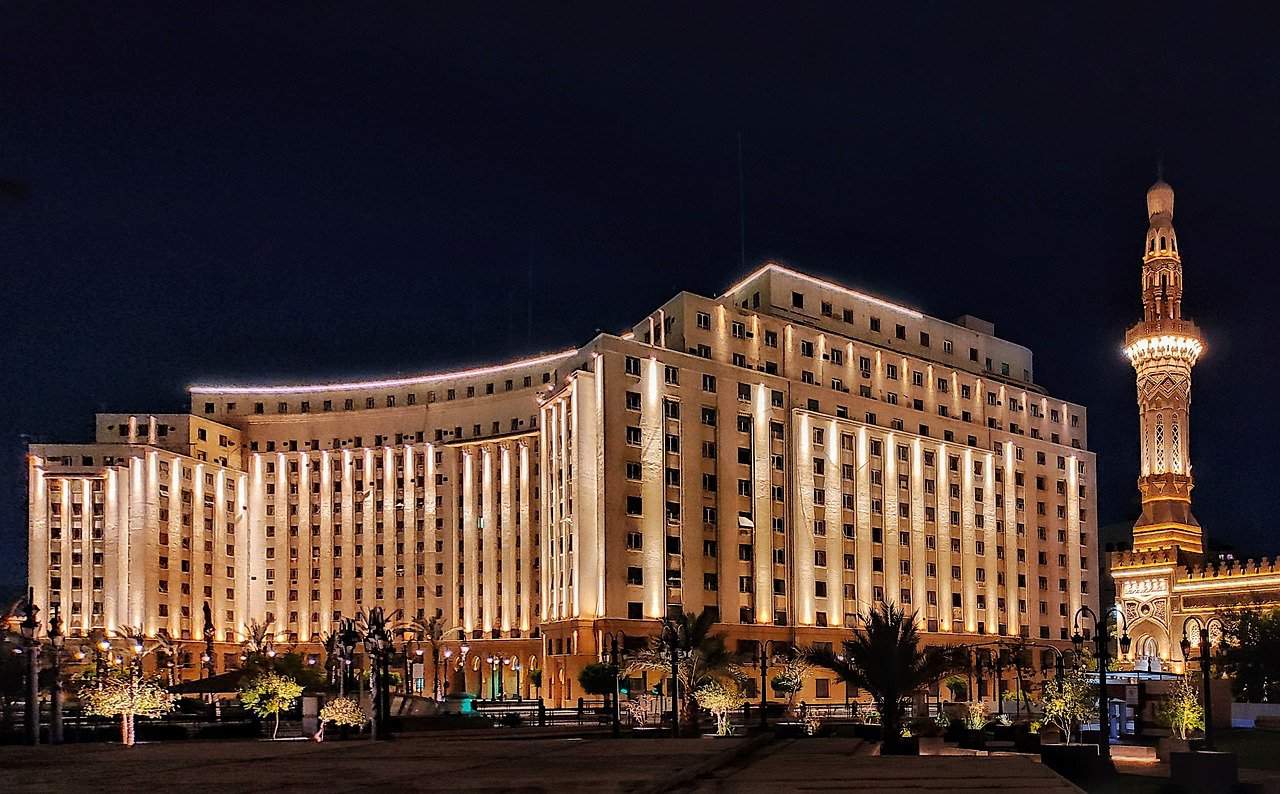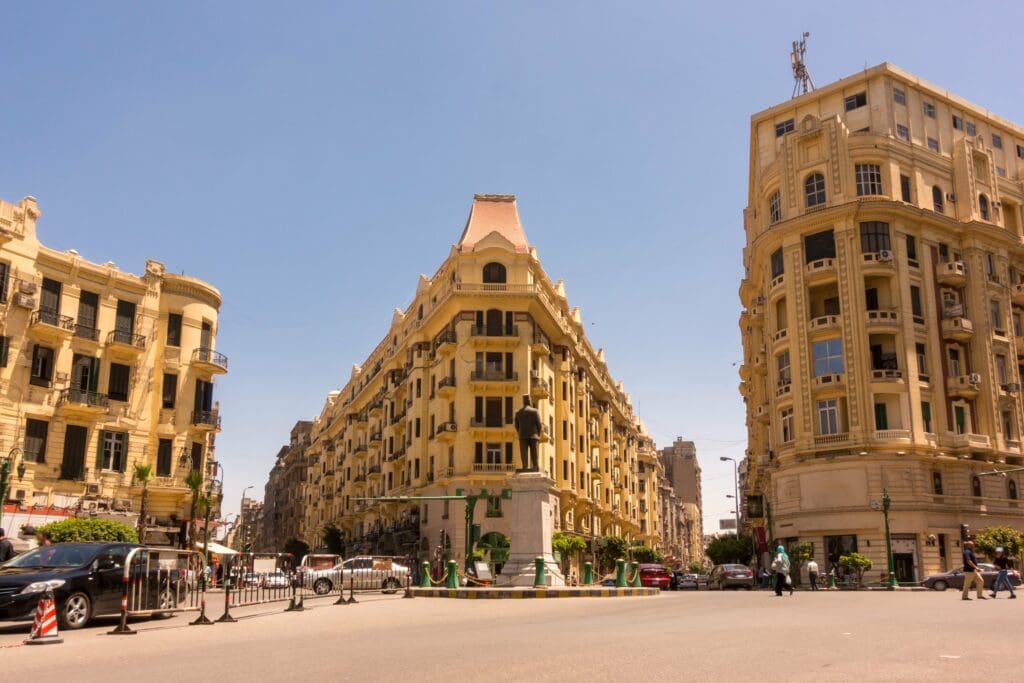Downtown -The Urban Center of Cairo, Egypt

Updated On: April 07, 2024 by Marwa Alaa
Cairo is one of the most splendid cities in the world. Reading about the city is one thing, but roaming its streets is different. What is interesting about Cairo is the fact that you can walk through its streets and have a glimpse of its past. The buildings, the roads, and the statues say it all. Many districts speak of the tremendous history of the city, but downtown remains on top.
Downtown is one of the oldest districts in Cairo. It is one of the neighbourhoods that have witnessed incidents of the past and the future. Despite its crowdedness and constant traffic jams, you will still enjoy the scenery it provides. Strolling around the streets and the buildings is a thrilling journey through the past.
The Founding Of The District Of Downtown
The downtown neighbourhood is one of the oldest districts in Cairo. However, it is not as old as Egypt is. The old downtown district is Two centuries old. The area started during the early years of the 19th century. Before that time, it was an abandoned desert with no landmarks or paved streets. Since it is even close to the location of the Nile River, the waters used to flood the area annually. With no constructions around, there was nothing that stopped the flood that took place on the banks of the river.
About Khedive Ismail Pasha
Thanks to Khedive Ismail Pasha, he altered the desert state of that area. Khedive Ismail Pasha was the grandson of Muhammad Ali Pasha, one of the most potent leaders in Egypt’s history. He launched a campaign to modernize Egypt and change most of its districts. Thus, he started his plans and developed many parts of what is now the downtown.
KhDowntownmail Pasha lived and received an education in Europe for most of his life. Consequently, he imposed his knowledge and the culture in which he grew up on his area planning. That is why many buildings reflect a European style Downtown. While building up the new downtown district, Khedive Ismail Pasha hired Baron Haussmann to assist. He was a French expert planner who contributed to providing us with the magnificence of the urban centre of Cairo.
Besides the foundation of the downtown district, Khedive Ismail Pasha also developed other organizations in modern Egypt. Those contributions included the establishment of the Orman Garden and the first Egyptian forest.
Downtown Through The Past And The Present
Nowadays, the downtown area is the centre of Cairo. It has been so for many years, becoming a top tourist destination. Visitors of Egypt and foreigners usually reside downtown during downtown accommodation in Cairo. Not only because it is pretty splendid and fascinating, but also because it is close to almost every other neighbourhood. It is so easy to get to different destinations from downtown. It dents the midsection between Cairo and Giza, where the Great Pyramids are located. Above and beyond, Downtown is Downtownor, which has more than a few landmarks and tourist attractions worth visiting.
In the past, downtown was famous for being home to the elite and the wealthy. The streets were designed so elegantly, which attracted people from the affluent classes to reside there. Moreover, it has always been home to the arts, a significant attraction for the elite. However, nowadays, things are not the same. The elegant community started crawling out of the region throughout the years. They moved to more recent places and left the urban centre behind. Consequently, the area became crowded with the society’s lower segment. That is why it became on top of the overcrowded areas of Cairo with suffocating traffic jams.
Home for Artists
Due to the undesired crowdedness of the area, it doesn’t look as graceful and glorious as it once did. No wonder the elite community had to flee to newer urban districts. However, that doesn’t mean that the iconic buildings of Downtown taste and appearance. They may not look as they once were, but they are still as beautiful. You can observe that splendour while visiting the area during the early times when it is quiet, and the streets are empty. Still, downtown is the best place to take impressive street photography. It has always attracted photographers and still does to this very day. It has always been a point of attraction for artists of different forms. Aside from photographers, well-known writers and authors also passed through those streets. They even spent their time in the coffee shops to write about its beauty.
Top Landmarks Of Downtown
As one of the top tourist destinations in Cairo, several spots are now among the region’s landmarks. Those landmarks include two famous cafés that have survived for very long years, as well as squares. The most famous square is Talaat Harb Square. You can’t help but hear that name so often while speaking of downtown. Downtown Abdeen Square and a palace that resonates with the same name are close to it. They all have history and stories to tell, both historical and political.
On the other hand, Downtown famous coffee shops, Café Riche and Groppi. They are as old as time, so they became remarkable landmarks of the district. According to the locals, those two restaurants and cafes were the hype of Downtown in history. With the ongoing launching of new franchises and brands, they are not as they have always been. However, older people still pass by them and spend their time there. They are probably holding onto the memories that once existed around them.
Talaat Harb Square

Talaat Harb Square marks downtown. It doesn’t get used to that square where a statue of Talaat Harb himself stands in the middle. The name refers to the man who founded Banque Misr, the Bank of Egypt. He was also one of the prominent figures in the political world who played a significant role in history. Returning to the square leads to almost all the considerable spots around downtown. ThDowntowndes Groppi Café, you will pass by Talaat Harb Square to reach this destination.
Abdeen Palace
Abdeen Palace is located on Qasr El-Nil Street on the eastern side of Downtown Cairo. On the exact site of the palace sat a small mansion whose owner was Abidin Bey. However, Khedive Ismail Pasha built Abdeen Palace instead. Thus, the palace was given the name of the owner of the previous mansion. The construction of this palace lasted for around 10 years and was officially completed by 1874. Léon Rousseau was the French architect who designed the magnificent palace. He also used the help of other decorators from different nations, including Italian, Egyptian, Turkish, and more. The palace is famous for its exceptional decoration, consisting of pure gold and scattered clocks.
When the palace first came into being, it was the official government headquarters instead of Cairo Citadel. Authorities had used it for holding ceremonies and official events. However, all those events along the president’s residence moved to Etihadia Palace in Heliopolis, Cairo. While heading to the palace, you will pass by Abdeen Square. The name comes from the fact that the two landmarks are close. It is also the place where some festivals used to take place at some point in history.
Groppi
There is an interesting story behind this café hype. Groppi was the very first ice cream shop Cairo has ever had. Consequently, it became as famous as it is ever since. Being downtown for downtown or over, it has become a noteworthy district landmark.
Groppi was the name of a Swiss family. They were the ones to start launching that ice cream shop in Egypt. The Groppi family founded the café back in 1909. Downtown was at its finest during that period, and the elite community resided there. However, it was only during the 80s that the Groppi family gave up the shop’s ownership. Abdul Aziz Lokma was the new owner; he bought the shop from the original family. Thanks to him, he could keep the brand alive until this very day. Although there are many more famous ice cream shops in Cairo now, this one remains among the popular destinations.
Café Riche
In 1908, Café Riche arrived in Egypt right before Groppi did. This café is still one of the significant hallmarks of the downtown district. It was popular with a different name when it first came to being. However, people nowadays call it Café Riche as it has always remained after the change. In 1914, Henry Recine bought the café and changed its name to French, like himself. Shortly after, the café was sold once again. That time, the new owner was the Greek Michael Nikoapolits. It was expected that the name would undergo another change. However, it kept the name Henry Recine, the French man who had given it ever since.
Aside from its constant changes of names, this café, in particular, had witnessed many incidents. Some of those incidents were substantial in the history of politics. For example, it was the place that gathered King Farouk with his second wife. Moreover, it was the same place where the assassination of the last Coptic Prime Minister of Egypt came to pass. Luckily, the assassination attempt failed anyway. Besides those events, Café Riche was where artists of all forms gathered. It attracted philosophers, writers, revolutionists, and more. It also happens to be where the revolutionists gathered in its basement during the revolution of 1919.
Yacoubian Building
Downtown reflects the European style in most of its buildings; French is the most dominant. This alone makes the area quite elegant and eye-catching. However, there’s more to this district than just its picturesque scenery. Most buildings that stand tall around the streets of downtown have devastating stories. Some were written in books and made into a motion picture. This, in particular, applies to the Yacoubian Building, where a wide array of bizarre stories took place. The name comes from the last name of the owner of the building, Hagop Yacoubian. He was an Armenian man who built this structure for affluent people to accommodate it. That considerable building attracted the elite community, so imagine what the rest of the area was like.
This building had witnessed stories about the lives of people who lived within. Secrets were kept within its walls during its finest years through the 30’s and the 40’s. However, someone spilt those secrets, making the building the centre of attention of many artists. On top of those artists was the Egyptian author Alaa Al Aswany. He succeeded in gathering those exciting secrets about the building and keeping them within a book. The novel was entitled “Omaret Yacoubian”, the Arabic equivalent of the Yacoubian building. In the 21st century, the story was made into a motion picture in which the superstar Adel Imam starred. It was one of the Oscar-winning movies in the history of film and cinema.
Tamara Building
The Yacoubian building is not the only iconic structure in downtown. TamDowntownlding is another significant one and one of the landmarks of the area. The building is located on Gawad Hosny Street, one of the most famous streets downtown. It was downtown in 1910 and inhabited by people of the highest segments of society. This building, in particular, is quite noteworthy. It may be among the few buildings in downtown that the European styles. It reflects the American style found in the buildings of Queens, New York.
The Diplomatic Club
Before becoming the Diplomatic Club, that building was a hub for the affluent and the wealthy. Back then, it was known as the Muhammad Ali Pasha Club. However, its name has now changed to the Diplomatic Club. It is one of the iconic buildings of downtown. It was designed back in 1908 by the French architect Alexandre Marcel. The latter is the designer of the gorgeous Baron Palace in Heliopolis, Cairo.






